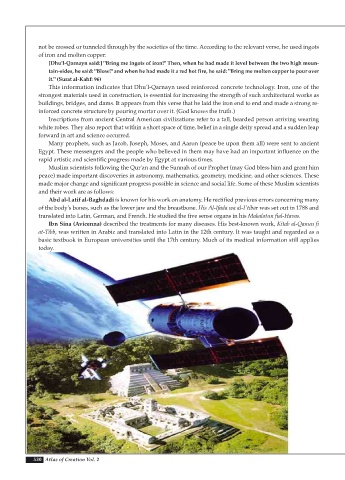Page 532 - Atlas of Creation Volume 2
P. 532
not be crossed or tunneled through by the societies of the time. According to the relevant verse, he used ingots
of iron and molten copper:
[Dhu'l-Qarnayn said:] "Bring me ingots of iron!" Then, when he had made it level between the two high moun-
tain-sides, he said: "Blow!" and when he had made it a red hot fire, he said: "Bring me molten copper to pour over
it." (Surat al-Kahf: 96)
This information indicates that Dhu'l-Qarnayn used reinforced concrete technology. Iron, one of the
strongest materials used in construction, is essential for increasing the strength of such architectural works as
buildings, bridges, and dams. It appears from this verse that he laid the iron end to end and made a strong re-
inforced concrete structure by pouring mortar over it. (God knows the truth.)
Inscriptions from ancient Central American civilizations refer to a tall, bearded person arriving wearing
white robes. They also report that within a short space of time, belief in a single deity spread and a sudden leap
forward in art and science occurred.
Many prophets, such as Jacob, Joseph, Moses, and Aaron (peace be upon them all) were sent to ancient
Egypt. These messengers and the people who believed in them may have had an important influence on the
rapid artistic and scientific progress made by Egypt at various times.
Muslim scientists following the Qur'an and the Sunnah of our Prophet (may God bless him and grant him
peace) made important discoveries in astronomy, mathematics, geometry, medicine, and other sciences. These
made major change and significant progress possible in science and social life. Some of these Muslim scientists
and their work are as follows:
Abd al-Latif al-Baghdadi is known for his work on anatomy. He rectified previous errors concerning many
of the body's bones, such as the lower jaw and the breastbone. His Al-Ifada wa al-I'tibar was set out in 1788 and
translated into Latin, German, and French. He studied the five sense organs in his Makalatun fial-Havas.
Ibn Sina (Avicenna) described the treatments for many diseases. His best-known work, Kitab al-Qanun fi
at-Tibb, was written in Arabic and translated into Latin in the 12th century. It was taught and regarded as a
basic textbook in European universities until the 17th century. Much of its medical information still applies
today.
530 Atlas of Creation Vol. 2

